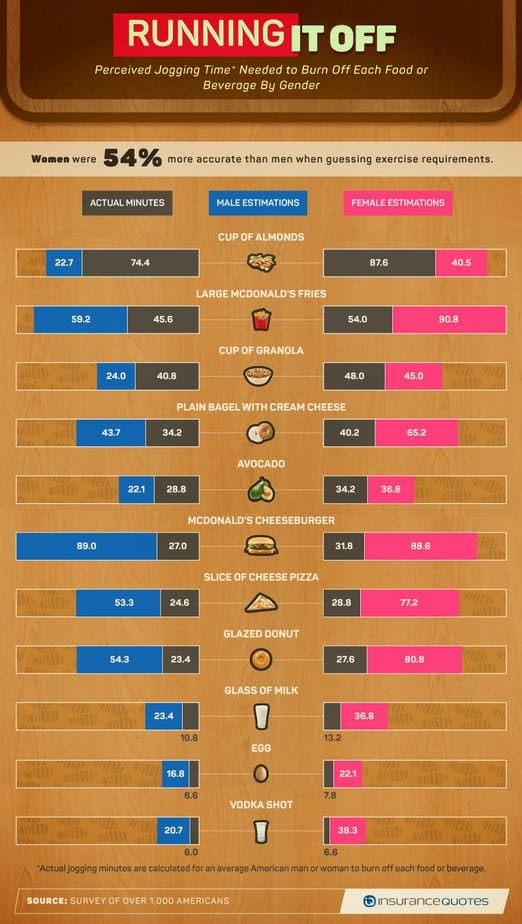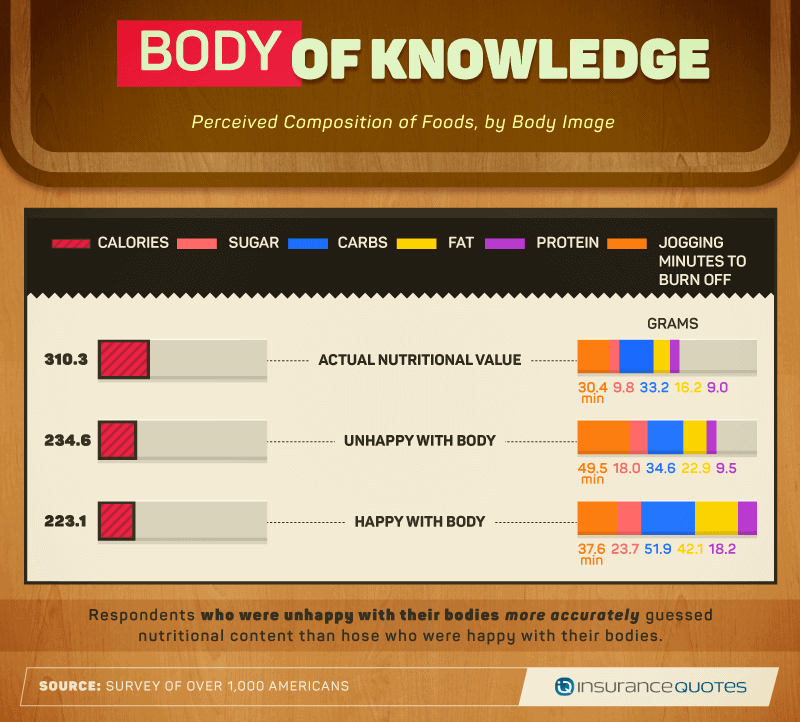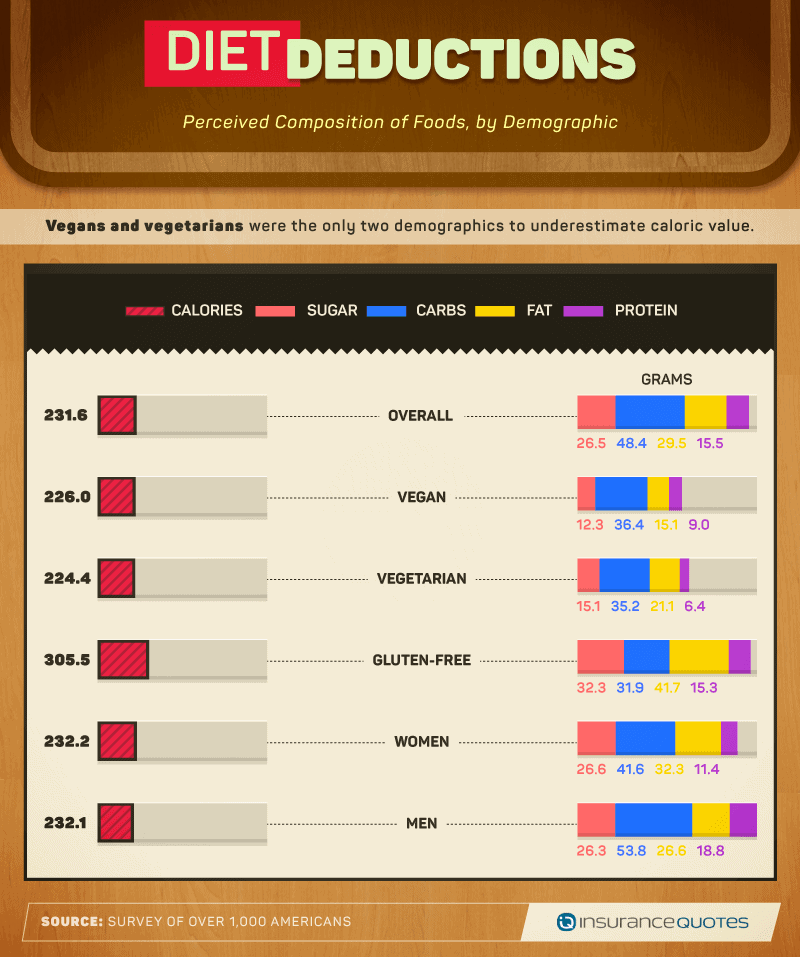Guess the Health Consequences of What You Eat

You are what you eat, and thanks to U.S. laws requiring nutritional information to be present on the packaging of consumables, knowing what you’re ingesting is easier than ever. What Americans choose to do with this information is entirely up to them, however. Considering the obesity epidemic America is currently fighting, nutritional values are probably ignored more often than not, leaving many people ill-informed and undernourished.
The energy (measured in calories) we get from food comes from protein, carbohydrates, and fat. Given that everything consumed is measured by these values, it would seem plausible that Americans would have a general understanding of nutrition; however, that does not seem to be the case.
When asked to guess calories for all foods and beverages surveyed, Americans were the most inaccurate when it came to healthier items. On average, respondents underestimated the number of calories in a cup of almonds by over 660 calories. They also assumed a somewhat low-calorie count in avocados, estimating an avocado was 148 calories on average when, in fact, it was 322 calories. However, Americans were pretty accurate when it came to vodka, only overestimating by an average of 31 calories.
Guessing carbohydrates, on the other hand, gave Americans the most trouble when it came to unhealthy foods. People assumed a McDonald’s cheeseburger had nearly 175 grams of carbs, over five times as much as the actual value (33 grams). They also thought a cup of granola only had 27 grams of carbs when, in reality, it had just over 80 grams.
Fat has a particularly bad rep these days. Although many high-fat foods can be nutritious, Americans tended to associate unhealthy foods with high-fat contents. On average, they assumed a slice of cheese pizza had 48 grams of fat when it had less than 10 grams in actuality. Participants also thought a glazed donut had about 42 grams of fat, but the circular treat had far less – 14 grams.
Sugar also presented a similar issue, with Americans overestimating grams overall. They were the furthest off when guessing the sugar content of a can of Coke, and closest to guessing the correct amount in a glass of whole milk.
Finally, a look at protein resulted in a healthy mix of over and underestimations on the part of participants. Almonds had nearly twice the amount of protein than Americans thought, while a slice of cheese pizza had less than half the amount of protein than people guessed.
12 Food and Beverage Items Under the Magnifying Glass
Avocados may well be one of the trendiest foods in recent years, with the constant demand for the product contributing to a 125 percent increase in wholesale prices in 2017. Millennials (often centered at the heart of this trend) are even sacrificing important financial opportunities to satisfy their guac cravings. In spite of Americans’ ever-growing love for avocados, they were surprisingly ill-informed when surveyed about their nutritional content. Participants assumed the calorie content to be less than half of what it really was.
Gluten-free respondents were the closest to guessing the correct calories, but not by much: They estimated an average of nearly 169 calories, more than 150 calories less than the actual 322 calorie count. That said, gluten-free participants were the farthest away from accurately estimating the protein content, guessing 9.8 grams instead of just the 1.3 grams an avocado actually contains.
Avocados may be experiencing a run for their money, however, as donuts could be coming to take the spot for the trendiest food. Everything from “glonuts” to entire walls featuring these desserts have popped up in recent years. Despite the creativity of the beloved donut industry, Americans seem misguided as to what a donut exactly does to their bodies. Vegans underestimated the calorie content, while other respondents tended to overestimate. Gluten-free participants most overestimated the fat content, but average Americans most overestimated the grams of sugar.
Although most alcohols are still consumable under vegan dietary restrictions, vegan respondents most grossly overestimated the carbohydrate content of a shot of vodka. However, Americans, in general, overestimated the fat content overall. Vodka contains no sugar, carbs, fat, or protein. Ironically, Americans still happily consume the foods and beverages they mistakenly assume are even worse than they actually are!
Gluten-free respondents had the hardest time guessing what was really in a can of Coke. They estimated most inaccurately on all fronts: calories, protein, sugar, carbs, and fat. Perhaps those with harsher dietary restrictions can better control any temptation for unhealthy foods by overestimating the caloric consequences.
Just Jog-off Those Extra Calories, Right?

Certain types of sugar, fat, carbs, and even protein can have negative health consequences, but the minutes it takes to burn off calories through exercise is perhaps the most tangible variable of them all. Although experts say that even just a few minutes of daily exercise is good for your health, many of the foods we asked about required much more work.
We asked respondents to guess how many minutes of jogging it would take to burn off various foods and beverages. We then compared these numbers to the actual amount of time it would take for the average American man or woman to jog the calories away. Overall, women tended to assume longer workout requirements than men to burn off various consumables.
At the top of our list? Almonds. Just one cup of these nuts will take the average American man or woman 74.4 and 87.6 minutes to jog off, respectively. Women were much closer than men to guessing exercise consequences for almonds, assuming a 40.5-minute jog would be necessary, while men guessed only 22.7 minutes.
A shot of vodka would take the shortest amount of time to jog off, but women overestimated that time more so than men. Women also thought a glazed donut would take 80.8 minutes of jogging to burn off, whereas it would really only require 27.6 minutes of their time.
Confidence in Your Body

Beyond diet (veganism, gluten-free, etc.), we were interested in comparing a person’s overall sense of happiness and confidence with their bodies against their nutritional knowledge. We asked each respondent whether they considered themselves to be happy or unhappy with their current physiques.
Those who were unhappy with their physical appearance more accurately guessed the calorie, carbs, fat, protein, and sugar contents of various foods, on average – but not by much. The only area where body-confident respondents guessed more accurately was the average minutes of jogging it took to burn off certain foods.
Diets and Demographics

Next, we looked at who most accurately estimated the nutritional values of foods and beverages by demographic. On average, women guessed within one single calorie of the average count for all 12 foods and beverages. Men and women both guessed within one gram of their average sugar contents. And men guessed carbohydrates the most accurately, while women were the best at guessing grams of fat. Finally, gluten-free respondents were the closest to guessing the grams of protein for the foods and beverages analyzed.
Conclusion
After averaging the responses of over 1,000 Americans, it appears that the details of middle school health classes have faded into distant memory. Unless you’re consistently reading nutrition labels or doing your own health research, the odds are that you are over or underestimating the consequences of healthy and unhealthy foods. Regardless, knowing exactly what you’re putting in your body can only take you so far.
No matter how much you focus on or ignore your body’s nutritional requirements, it’s certainly best to be prepared for all health-related situations. At insuranceQuotes.com, you can easily find a health insurance plan that will best suit you and your family’s well-being, so head on over to see all of the healthcare options available to you today.
Methodology
We surveyed over 1,000 Americans of all genders, locations, and dietary restrictions. We asked respondents to guess the number of calories, grams of protein, fat, sugar, and carbohydrates for each food or beverage analyzed, and how many minutes of jogging it would take to burn off each item. Finally, we asked respondents to determine whether they were happy or unhappy with their bodies. Responses from every demographic were then averaged and compared to the actual nutritional content of each food or beverage.
Sources
- https://wa.kaiserpermanente.org/healthAndWellness/?item=%2Fcommon%2FhealthAndWellness%2Fconditions%2Fdiabetes%2FfoodProcess.html
- https://www.nbcnews.com/health/health-news/america-s-obesity-epidemic-hits-new-high-n587251
- http://www.merckmanuals.com/home/disorders-of-nutrition/overview-of-nutrition/carbohydrates,-proteins,-and-fats
- https://www.healthline.com/nutrition/10-super-healthy-high-fat-foods
- http://money.cnn.com/2017/09/09/news/economy/avocado-prices-soar/index.html
- https://www.cnbc.com/video/2017/09/07/millennials-are-choosing-avocado-toast-and-travel-over-buying-a-home.html
- http://mashable.com/2017/06/09/glonut-trend/#IlYXxnIR65qP
- https://www.boredpanda.com/wedding-donut-wall/
- https://www.healthline.com/health/food-nutrition/vodka-calories#carbs-in-vodka3
- https://www.wsj.com/articles/why-a-few-minutes-of-exercise-can-show-results-1460993589
Fair Use Statement
Want to share our food for thought for noncommercial purposes only? Don’t be shy! But please make sure to link back to this page and its authors, so they receive due credit for their research and analysis.
